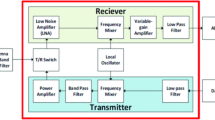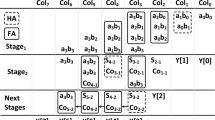Abstract
To improve the convergence speed and noise cancellation performance of the Delayed Filtered-x Least Mean Square (DFxLMS) algorithm in the hardware implementation of compressor noise cancellation system, an improved Delayed Filtered-x Least Mean Square algorithm based on field-programmable gate array (FPGA) is proposed. The algorithm uses a parallel finite impulse response (FIR) filter structure and DSP48E1 module to implement the parallel multiplication and addition operation, which decreases hardware resource consumption and increases the system’s processing speed. The cut set retiming technique reallocates the location of delay units to streamline the algorithm structure, reduce the critical path delay and increase the system data throughput. Moreover, through the adaptive filtering of input and feedback signals of the filter module, the noise suppression effect of the algorithm is improved. The results show that the maximum noise cancellation of the algorithm is 10 dB in the compressor noise cancellation system, which is 3 dB higher than the DFxLMS algorithm, and has 1.5 times higher data throughput. In addition, the Lookup Table (LUT), Flip-Flop (FF), and power consumption decreased by 18.5%, 33.6%, and 26.6%, respectively, and converged 1.8 times as fast.





















Similar content being viewed by others
Data Availability
The data that support the findings of this study are available from the corresponding author upon reasonable request.
References
M. Basner, S. McGuire, WHO environmental noise guidelines for the European region: a systematic review on environmental noise and effects on sleep. Int. J. Environ. Res. Public Health 15(3), 519 (2018). https://doi.org/10.1007/s40726-017-0062-8
C.Y. Chang, S.M. Kuo, C.Y. Ho et al., Analysis and enhancement of narrowband active noise control systems with disturbance. J. Vib. Control 24(11), 2247–2260 (2018). https://doi.org/10.1177/107754631668447
C.Y. Chang, S.M. Kuo, C.W. Huang, Secondary path modeling for narrowband active noise control systems. Appl. Acoust. 131, 154–164 (2018). https://doi.org/10.1016/j.apacoust.2017.10.026
N. Garg, Noise Sources: Characteristics and Control. Environmental Noise Control—The Indian Perspective in an International Context. Cham: Springer International Publishing. 2022, 27–62. https://doi.org/10.1007/978-3-030-87828-3
P.Y. Ge, Research on active control system for in-vehicle noise based on multi-gradient adaptive algorithm. Jilin: Jilin University. https://doi.org/10.1007/s00034-020-01410-0
P. Goel, M. Chandra, FPGA implementation of adaptive filtering algorithms for noise cancellation—A technical survey. In: Proceedings of the third international conference on microelectronics, computing and communication systems: MCCS 2018. 2019, 517-526. https://doi.org/10.1007/978-981-13-7091-5_42
P. Goel, M. Chandra, VLSI implementations of retimed high speed adaptive filter structures for speech enhancement. Microsyst. Technol. 24(12), 4799–4806 (2018). https://doi.org/10.1007/s00542-018-3884-4
A. Gohn, J. Kim, Implementation of LMS adaptive filter algorithm based on FPGA. 2019 IEEE 62nd International Midwest Symposium on Circuits and Systems. 2019, 207–210. https://doi.org/10.1109/MWSCAS.2019.8885239
C.Y. Ho, K.K. Shyu, C.Y. Chang et al., Efficient narrowband noise cancellation system using adaptive line enhancer. IEEE/ACM Trans. Audio Speech Lang. Process. 28, 1094–1103 (2020). https://doi.org/10.1109/TASLP.2020.2982578
S. Lv, Research on active noise control methods for automotive engines. Heilongjiang: Harbin Institute of Technology, pp. 1–56 (2019)
D. Mendez, D. Arevalo, D. Patino et al., Parallel Architecture of reconfigurable hardware for massive output active noise control. Parallel Process. Lett. 29(03), 1950014 (2019). https://doi.org/10.1142/S0129626419500142
H. Meng, S. Chen, A modified adaptive weight-constrained FxLMS algorithm for feedforward active noise control systems. Appl. Acoust. 164, 107227 (2020). https://doi.org/10.1016/j.apacoust.2020.107227
B.K. Mohanty, G. Singh, G. Panda, Hardware design for VLSI implementation of FxLMS-and FsLMS-based active noise controllers. Circuits Syst. Signal Process. 36(2), 447–473 (2017). https://doi.org/10.1007/s00034-016-0311-x
A. Patnaik, R.K. Patjoshi, R. Panigrahi, An experimental investigation of fpga-based lms algorithm for adaptive noise cancellation. Electron. Syst. Intell. Comput. Proceed. ESIC 2020, 719–730 (2020). https://doi.org/10.1007/978-981-15-7031-5_68
E. Peris, Environmental noise in Europe: 2020. Eur. Environ. Agency. 1, 104 (2020)
J. Radun, H. Maula, P. Saarinen et al., Health effects of wind turbine noise and road traffic noise on people living near wind turbines. Renew. Sustain. Energy Rev. 157, 112040 (2022). https://doi.org/10.1016/j.rser.2021.112040
R. Sangeeta, S. Padmapriya, Investigations on pipeline optimized adaptive fir filter architecture for audio de-noising. Adv. Smart Syst. Technol. Select Proc. ICFSST 2021, 155–174 (2019). https://doi.org/10.1007/978-981-15-5029-4_13
D. Shi, C. Shi, W.S. Gan, A systolic FxLMS structure for implementation of feedforward active noise control on FPGA. Asia-Pacific Signal Inf. Process. Assoc. Ann. Summit Confer. 2016, 1–6 (2016)
D.Y. Shi, W.S. Gan, B. Lam et al., Two-gradient direction FxLMS: an adaptive active noise control algorithm with output constraint. Mech. Syst. Signal Process. 116, 651–667 (2019). https://doi.org/10.1016/j.ymssp.2018.06.062
C. Venkatesan, P. Karthigaikumar, R. Varatharajan, FPGA implementation of modified error normalized LMS adaptive filter for ECG noise removal. Clust. Comput. 22, 12233–12241 (2019). https://doi.org/10.1007/s10586-017-1602-0
I. Yamazaki, S. Tomov, J. Dongarra, Stability and performance of various singular value QR implementations on multicore CPU with a GPU. ACM Trans. Math. Softw. 43(2), 1–18 (2016). https://doi.org/10.1145/2898347
J. Yuan, X. Meng, J. Ran et al., Design of high-speed delay-FxLMS hardware architecture based on FPGA. Int. J. Circ. Syst. Signal Process. 16, 764–772 (2022)
J. Yuan, X. Meng, Q. Zhao et al., Structure design of fine-grained two-parallel systolic FxLMS filter based on FPGA. Microprocess. Microsyst. 93, 104604 (2022). https://doi.org/10.1016/j.micpro.2022.104604
Acknowledgements
This work was supported by the National Natural Science Foundation of China Youth Program (62105048), the Major Science and Technology Project of Chongqing Science and Technology Bureau (cstc2018jszx-cyztzxX0054), the Major Integrated Circuit Industry Project of Chongqing Science and Technology Commission (cstc2018jszx-cyztzx0217) and the Natural Science Foundation of Chongqing Science and Technology Bureau (CSTB2022NSCQ-MSX1389).
Author information
Authors and Affiliations
Corresponding author
Ethics declarations
Conflict of interest
The authors declare that they have no known conflict of interests that could have appeared to influence the work reported in this study.
Ethical approval
This article does not contain any studies with human participants or animals performed by any of the authors.
Informed consent
Informed consent was obtained from all individual participants included in the study.
Consent to Participate
This manuscript is approved by all authors for publication.
Additional information
Publisher's Note
Springer Nature remains neutral with regard to jurisdictional claims in published maps and institutional affiliations.
Rights and permissions
Springer Nature or its licensor (e.g. a society or other partner) holds exclusive rights to this article under a publishing agreement with the author(s) or other rightsholder(s); author self-archiving of the accepted manuscript version of this article is solely governed by the terms of such publishing agreement and applicable law.
About this article
Cite this article
Yuan, J., Zhang, Y., Yuan, C. et al. FPGA Design and Implementation of Improved DFxLMS Algorithm for Compressor Noise Cancellation System. Circuits Syst Signal Process 43, 2560–2584 (2024). https://doi.org/10.1007/s00034-023-02577-y
Received:
Revised:
Accepted:
Published:
Issue Date:
DOI: https://doi.org/10.1007/s00034-023-02577-y




